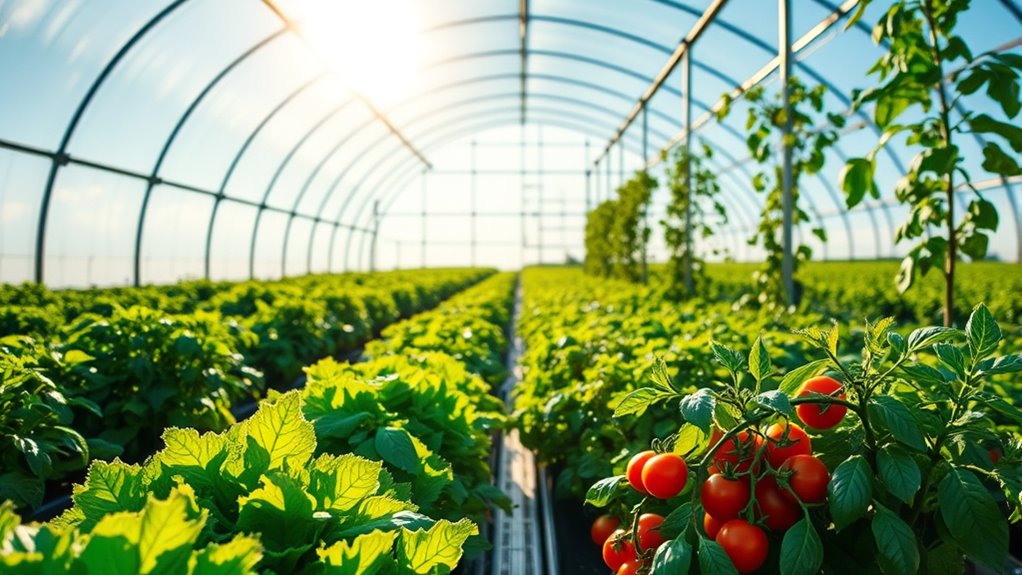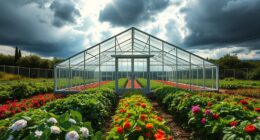By starting a greenhouse garden, you can grow fresh produce year-round right in your own space, sharply reducing food miles and cutting your carbon footprint. Using renewable energy like solar power for heating and lighting makes your setup even more eco-friendly. Growing your own veggies and herbs minimizes dependence on imported foods, reducing transportation emissions. If you keep exploring, you’ll discover simple ways to optimize your greenhouse and further enhance its environmental benefits.
Key Takeaways
- Greenhouse gardening allows year-round local food production, reducing the need for transportation of imported produce.
- Growing herbs and vegetables at home cuts food miles, minimizing emissions from long-distance transportation.
- Utilizing renewable energy in greenhouses decreases reliance on fossil fuels, lowering overall carbon footprint.
- Shortening supply chains through urban greenhouses enhances freshness and reduces environmental impact.
- Promoting sustainable practices in greenhouse gardening fosters eco-conscious lifestyles and resource conservation.

Growing your own food in a greenhouse not only provides fresh, delicious produce but also helps reduce your carbon footprint. By embracing greenhouse gardening, you take control of your food sources and minimize the environmental impact associated with traditional farming and supermarket supply chains. This practice is especially effective if you’re interested in urban farming, where limited space and high population densities demand innovative solutions. With a greenhouse, you can convert small city plots or even rooftops into productive vegetable gardens, reducing the need for food transportation over long distances. That means fewer food miles, less fossil fuel consumption, and a smaller carbon footprint overall.
Using renewable energy to power your greenhouse further amplifies its environmental benefits. Solar panels or wind turbines can supply the energy needed for heating, lighting, and ventilation, making your setup more sustainable. By relying on renewable sources, you decrease dependence on fossil fuels and cut greenhouse gas emissions associated with energy consumption. Additionally, incorporating energy-efficient systems like LED grow lights and automated climate controls helps optimize resource use, ensuring your plants thrive with minimal environmental impact. This approach aligns perfectly with the principles of eco-friendly urban farming, combining modern technology with sustainable practices.
Greenhouse gardening in urban areas also offers a way to promote local food production, which cuts down on the need for imported produce. By growing your own herbs, vegetables, and even small fruit trees, you limit your reliance on store-bought goods that often travel hundreds or thousands of miles. This not only preserves freshness and flavor but profoundly reduces the emissions linked to transportation. Plus, with year-round growing capabilities, you can enjoy fresh produce regardless of the season, further decreasing your dependence on imported foods and their associated carbon costs.
Another advantage of greenhouse gardening is that it encourages a greener lifestyle and greater environmental awareness. When you grow your own food using renewable energy, you become more conscious of your consumption habits and resource use. This awareness can inspire you to adopt other sustainable practices, such as composting, rainwater harvesting, and organic pest control. Over time, these efforts contribute to a more resilient, eco-friendly urban environment.
Frequently Asked Questions
Can Greenhouse Gardening Be Done Year-Round in All Climates?
Greenhouse gardening can be done year-round in many climates, but climate adaptability varies. In milder regions, you might grow vegetables and herbs continuously, while colder climates face seasonal limitations. You’ll need to invest in proper insulation, heating, and ventilation to extend your growing season. Understanding your local climate helps you plan effectively, ensuring your greenhouse remains productive regardless of seasonal changes.
What Are the Initial Costs for Setting up a Greenhouse?
They say “you gotta spend money to make money,” and that’s true for setting up a greenhouse. Your initial costs include setup expenses like buying a frame, glazing materials, heating, and ventilation. Depending on size and quality, expect to spend a few hundred to several thousand dollars. While it’s an investment, these setup expenses can pay off with fresh, homegrown produce year-round, reducing your overall food costs.
How Much Water Does Greenhouse Gardening Typically Use?
Greenhouse gardening typically uses about 10-15 gallons of water per square foot annually, but this varies based on your water efficiency and irrigation methods. Using drip irrigation or automated systems helps you conserve water by delivering it directly to plant roots, minimizing waste. Regularly monitoring soil moisture ensures you don’t overwater, making your greenhouse more sustainable and reducing overall water usage.
Are There Specific Crops Best Suited for Greenhouse Cultivation?
You’ll find that crop selection depends heavily on your growing conditions. Vegetables like tomatoes, peppers, and herbs thrive in greenhouse environments because they adapt well and yield high. Leafy greens such as lettuce and spinach also do well if you maintain proper temperature and humidity. By choosing crops suited for your specific conditions, you maximize your greenhouse’s productivity and enjoy fresher, healthier produce all year round.
What Are the Common Pests and How to Manage Them Organically?
You’ll find common pests like aphids, whiteflies, and spider mites in your greenhouse. To manage them organically, start with pest control methods like introducing natural predators, such as ladybugs, or using insecticidal soaps and neem oil. Regularly inspect your plants, remove pests manually, and keep your greenhouse clean. Organic methods are eco-friendly and effective, helping you protect your crops without harmful chemicals.
Conclusion
By shrinking your food miles through greenhouse gardening, you not only nourish your body but also protect the planet. Imagine each seed you plant as a tiny act of rebellion against climate change—your own green revolution. So, why wait? Take control of your food’s journey from seed to plate, and let your garden be a beacon of hope. After all, small steps can light the way toward a greener, more sustainable future.









